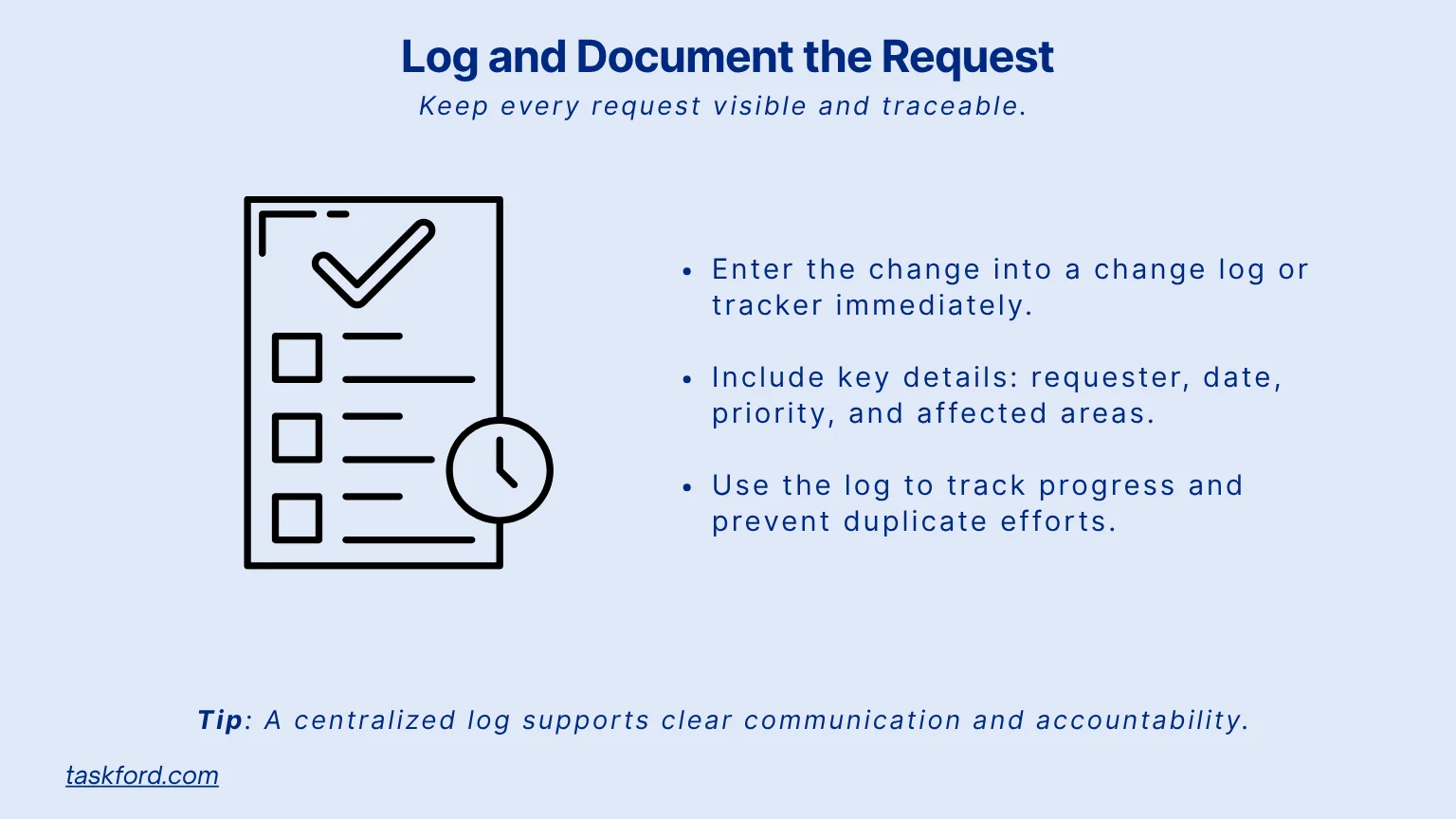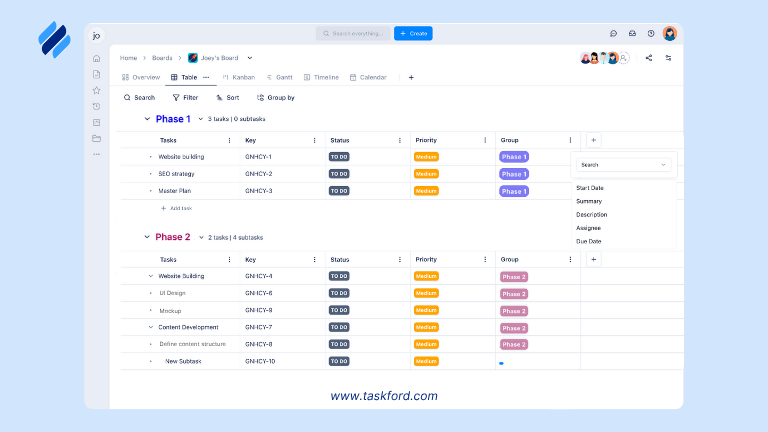Change Control Process: Definition, Steps & Benefits
Learn what a change control process is, its key steps, and benefits in project management to manage changes effectively and maintain project stability.
Projects rarely go exactly as planned. Scope, timeline, and budget often shift as requirements evolve or unforeseen issues arise. Without a structured approach, even small changes can create confusion, cause delays, or increase costs. This is where a change control process comes into play. It ensures that modifications to a project are carefully assessed, approved, and documented.
In project management, managing change is crucial for maintaining control over deliverables, resources, and timelines. Effective change control supports clear communication between teams, improves accountability, and enables project managers to respond to new challenges without compromising overall objectives. This article will explain what change control is, why it matters, outline its key steps, provide a practical example, highlight supporting tools, discuss common challenges, and explore the benefits of a strong process.
What Is a Change Control Process?
At its core, a change control process is a formal procedure to identify, evaluate, approve, and implement changes in a project. It is a component of project management that focuses specifically on changes to project deliverables, timelines, budgets, and resources.
Change control differs from broader change management, which often addresses organizational change or employee adaptation. Instead, change control ensures that every project-level adjustment is deliberate, documented, and approved by the relevant stakeholders.
The process applies to a variety of changes, including modifications to scope, schedule, costs, quality standards, or resource allocation. Industries such as IT, construction, engineering, healthcare, and software development rely heavily on change control to maintain order in complex projects.
Why Change Control Matters in Project Management
Implementing a change control process is essential in project management. Without it, even minor adjustments can cause disruptions. Consider the following risks:
- Scope creep: uncontrolled changes can alter project objectives, increasing workload and resource use.
- Delays: unplanned modifications may extend timelines, affecting deliverables.
- Cost overruns: additional work or resources without approval can inflate budgets.
- Misalignment between teams: departments may act independently, causing confusion or conflict.
A strong change control process addresses these risks by providing:
- Predictability: project managers can anticipate the impact of changes before implementation.
- Stakeholder alignment: everyone understands what changes are occurring and why.
- Auditability: documenting every change ensures compliance and provides a record for future projects.
Effective change control does not prevent change. Instead, it allows teams to respond to new requirements in a controlled, transparent, and efficient way, which is critical in modern project monitoring practices.
The Six Key Steps in the Change Control Process
A robust change control system typically follows six steps. These steps provide a structured approach to handling change requests and ensuring that no decision is made in isolation.

Step 1: Identify the Need for Change
The first step is recognizing when a change is required. Changes can arise from evolving client requirements, technical issues, regulatory updates, or unforeseen project challenges. A clear description of the requested change is essential. Teams usually document it in a change request form that includes the reason for the change, the affected deliverable, and the expected impact.
Tip: Even small adjustments should be captured to ensure no change is implemented without awareness.
Step 2: Log and Document the Request

Once a change is identified, it should be entered into a change log or tracking system. This log becomes the central record for all requests and is critical for transparency and accountability. Include essential details like:
- Who submitted the request
- Affected tasks or deliverables
- Priority level
- Submission date
Practical note: Maintaining a change log allows project managers to monitor trends, assess workload impact, and provide stakeholders with a clear overview of all pending changes.
Step 3: Evaluate and Analyze the Change
This is often the most detailed and critical step in the entire process. It’s where the project team carefully examines what the proposed change means for the project as a whole.
Evaluation typically covers four main areas:
- Impact on scope, timeline, and budget: Will this change require more time, people, or money? Will it alter project deliverables?
- Risk analysis: Are there any potential risks introduced by the change, such as technical conflicts or quality issues?
- Stakeholder input: Involving the right people like project managers, technical leads, or financial controllers ensures the evaluation is accurate and balanced.
- Cost-benefit consideration: The team weighs the benefits of implementing the change against the cost and disruption it might cause.
At this stage, the goal isn’t to make a decision yet but to provide a clear picture of the potential implications so the approval team can make an informed choice later.
Example: If a client requests a new feature, analysis may reveal additional development time, testing cycles, and potential effects on project deadlines.
Step 4: Review and Approve or Reject

After evaluation, the request goes to the Change Control Board (CCB) or project sponsor for approval. Decisions are based on feasibility, alignment with project objectives, budget implications, and risk. Some changes are urgent and may be fast-tracked, while others can be deferred or rejected.
Tip: Clear approval guidelines prevent delays and ensure accountability for every decision.
Step 5: Implement the Approved Change
Once approved, the change is incorporated into the project plan. Teams update schedules, reassign tasks, allocate resources, and communicate adjustments to all stakeholders. Proper implementation ensures the change is executed efficiently without introducing errors or confusion.
Practical note: Using project management tools helps track progress and integrates the change into ongoing project monitoring.
Step 6: Review and Close
The final step is verifying that the change has been successfully implemented and meets its objectives. Project documents are updated, the change log is marked as complete, and any lessons learned are recorded. This step ensures accountability and helps improve the process for future changes.
Example: A feature added to a website is tested to confirm functionality, and its performance is compared to expected outcomes before the request is officially closed.
Example: Change Control in Action
To make the six-step process more tangible, consider a retail website redesign project. Midway through development, the marketing team requests a new feature: personalized product recommendations on the homepage.
The project manager logs the request and initiates the change control process. The team conducts an impact analysis and finds that the feature would extend the timeline by three weeks and increase the budget by $4,000. The projected improvement in user engagement makes the change worthwhile.
The Change Control Board reviews the findings and approves the request. The development team then implements the feature, and the project manager confirms that everything functions as expected. Finally, the request is closed and documented in the change log.
A simplified change log reflecting this and other requests might look like this:
| Project | Change ID | Request Title | Assignee | Priority | Change Type | Step Status | Notes |
|---|---|---|---|---|---|---|---|
| Website Redesign | CHG-01 | Add personalized product recommendations | Lead Dev | High | Scope | Completed | Logged, evaluated, approved, implemented, reviewed (+3 weeks, +$4,000) |
| Mobile App Update | CHG-02 | Delay analytics rollout due to bug | QA Lead | Medium | Schedule | In Review | Currently under evaluation by project sponsor |
| HR Portal Upgrade | CHG-03 | Update user roles for compliance | DevOps | High | Quality | Logged | Awaiting impact analysis before review |
This example shows how change control integrates with project monitoring, keeping stakeholders informed, tracking progress, and ensuring that each request moves methodically through evaluation, approval, and implementation.
Tools That Support Change Control
Effective change control often relies on digital tools and templates to improve consistency and visibility. Examples include:
- Project management and resource planning platform like TaskFord, which allows teams to log, assign, and track changes.
- Change request templates for documenting requests consistently, including fields like impact, priority, and approval status.
- Communication tools to ensure all stakeholders are informed about updates and deadlines.
Using the right tools reduces the risk of lost requests, improves accountability, and allows project managers to monitor changes alongside the overall project plan. Many organizations integrate change logs into dashboards for easier reporting and auditing.
TaskFord’s task management features allow project managers to log every change request as a separate, trackable task. Each request can be assigned to the relevant team member, tagged with a priority level, and linked to specific deliverables. This ensures that no change slips through unnoticed and every adjustment remains visible to all stakeholders.

Common Challenges and How to Overcome Them
While change control is critical, organizations often face challenges in implementing it effectively:
- Excessive bureaucracy: too many approval layers can slow down progress. Simplifying processes and automating notifications can help.
- Incomplete documentation: missing information leads to unclear decisions. Using standardized forms ensures all key details are captured.
- Stakeholder misalignment: teams may act independently. Regular review meetings keep everyone on the same page.
- Delayed approvals: assigning clear ownership and deadlines for each step helps avoid bottlenecks.
A balance between structure and flexibility is essential. The goal is not to prevent change but to manage it efficiently and transparently.
Benefits of a Strong Change Control Process
Implementing a robust change control system brings numerous advantages to any project:
- Predictability: teams can anticipate the impact of changes and adjust plans proactively.
- Transparency: stakeholders clearly understand what changes are being requested and why.
- Accountability: ownership of each request is clearly defined, reducing confusion.
- Compliance and auditability: detailed records support regulatory requirements and post-project evaluation.
- Continuous improvement: lessons from past changes inform future projects and decision-making.
- Enhanced stakeholder trust: clear processes show that changes are handled professionally and efficiently.
These benefits directly support project management objectives, improving both performance and team confidence while enabling better project monitoring.
Conclusion
Change is inevitable in any project. What separates successful projects from failing ones is not the absence of change but how it is managed. A structured change control process allows teams to evaluate requests, make informed decisions, and implement changes efficiently.
By combining clear documentation, defined approval paths, and effective communication, project managers can maintain control over scope, budget, and timelines while responding to new needs. Even a simple change log or lightweight template can make a significant difference in keeping a project on track.
Start by reviewing your current processes and tools, create a change log, and define clear steps for logging, evaluating, approving, and implementing changes. Doing so will improve accountability, enhance project monitoring, and help your team navigate change without disruption.
Learn more:
- What Is Project Management? A Beginner’s Comprehensive Guide 2026
- What Does A Project Manager Do? A Guide to Advancing Your Career
- 80 Key Project Management Terms You Should Know
Subscribe for Expert Tips
Unlock expert insights and stay ahead with TaskFord. Sign up now to receive valuable tips, strategies, and updates directly in your inbox.